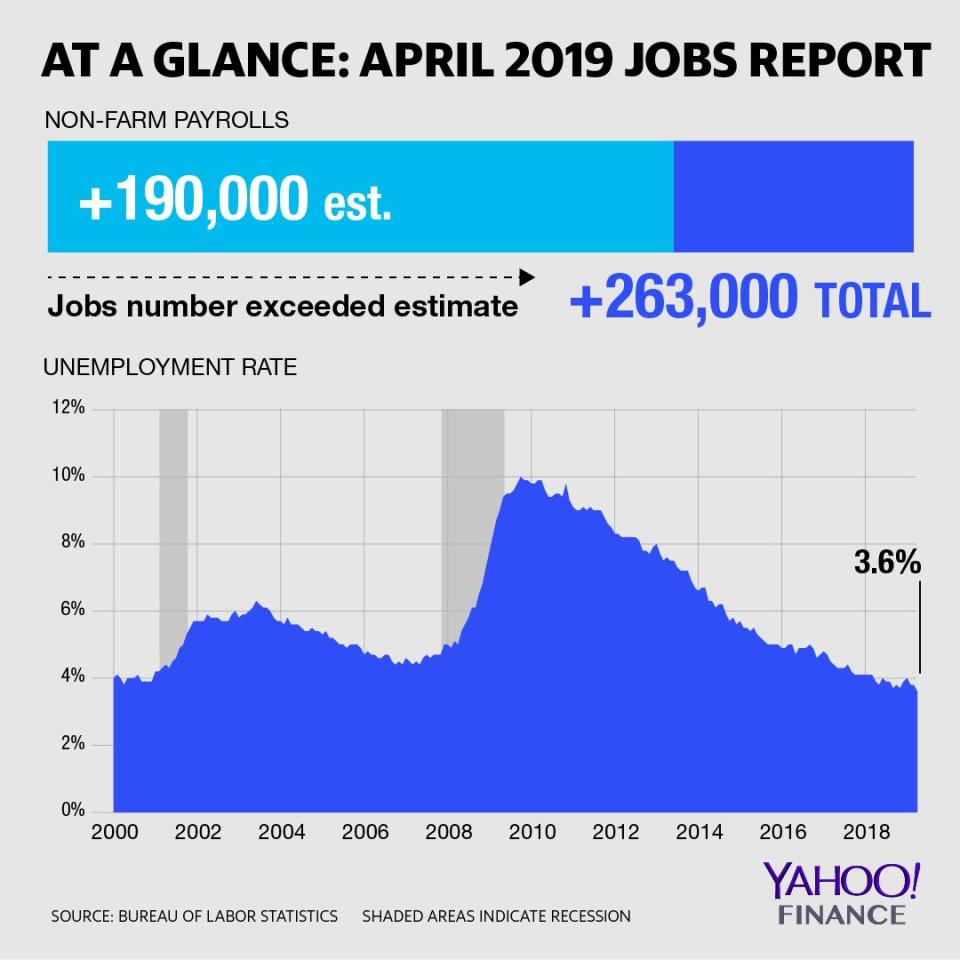Job creation smashes expectations, unemployment rate falls to 49-year low
The U.S. labor market charged ahead in April.
The economy added 263,000 non-farm payrolls for the month, the Bureau of Labor Statistics reported Friday. This topped expectations for 190,000 new positions, according to consensus estimates compiled by Bloomberg. March’s payroll additions were downwardly revised to 189,000, from 196,000 previously.
The unemployment rate fell to 3.6% for the month, the lowest level since December 1969. Consensus economists had anticipated that unemployment would hold at March’s 3.8% rate.
Meanwhile, the labor force participation rate fell slightly from March to 62.8%, but was unchanged from the year prior. The broad U-6 gauge of unemployment – which captures the underemployed as well as those who have ceased looking for jobs and – held at 7.3%, the same level seen in both February and March.
Average hourly earnings rose 0.2% month-over-month and 3.2% year-over-year, the same paces seen in March. Consensus economists had anticipated hourly wages to increase by 0.3% on a monthly basis and 3.3% on an annual basis.
Positions in the manufacturing sector grew by 4,000 in April, reversing a decline of 6,000 seen in March. However, this came in short of the 10,000 new manufacturing positions expected. Manufacturing job creation has been closely watched amid softness in the sector as a whole, with the Institute for Supply Management’s factory gauge falling to a two-year low in April.
The Bureau of Labor Statistics report comes on the heels of mixed employment data from other closely watched labor market indicators. ADP/Moody’s reported earlier this week that private payrolls increased by 275,000 in April, or nearly 100,000 positions more than expected. However, initial unemployment claims, which had been trending lower, recently rebounded, with Thursday’s latest reading showing new jobless claims rose by 230,000 on a seasonally adjusted basis during the last full week of April.
Meanwhile, the economy on the whole has shown signs of trending higher, based on the much stronger-than-expected reading on first-quarter GDP last week. According to that report, the U.S. economy grew at a pace of 3.2% in the first three months of the year, surging ahead of consensus expectations for 2.3% growth.
Fed Watch
Friday’s jobs report comes just two days following the Federal Reserve’s latest monetary policy decision and commentary from Fed Chair Jerome Powell, in which the central bank characterized economic activity as “solid.” The Federal Open Market Committee (FOMC) decided to keep key interest rates unchanged at a band of between 2.25% and 2.5%, with Powell subsequently telegraphing that the central bank does not see a “strong case” to change interest rates in either direction at this point.
In the statement, the FOMC noted that “job gains have been solid, on average, in recent months, and the unemployment rate has remained low.” Powell also said that he saw no signs of an overheating economy, and that wages have grown at an “appropriate” rate.
Friday’s jobs report looks to have affirmed the Fed’s stance, said Mark Hamrick, Bankrate.com senior economic analyst.

“The Federal Reserve looks at the past couple months of employment reports and certainly feels no urgency to cut rates as many investors have been hoping, or I’d say speculating,” Hamrick said. “As Fed officials’ favorite inflation gauge hasn’t been blinking red, they’ll remain relatively comfortable with leaving rates unchanged for the near-term.”
Central bank officials have been fixated on inflationary signals to determine the direction of future monetary policy, with Powell saying Wednesday he believed factors contributing to the current low levels of inflation were “transitory.”
While average hourly wages serve as one indicator of inflation, that metric isn’t as closely watched by Fed officials as their preferred gauge of underlying inflation, or core personal consumption expenditures (PCE). Core PCE came in at 1.6% year-over-year in March, well below the Fed’s 2% target.
“The April report brought strong job growth and lower unemployment. Wage growth is comfortably above inflation, and the fact that it failed to tick up serves to stifle any talk of a rate hike,” Curt Long, chief economist for the National Association of Federally-Insured Credit Unions, wrote in an email. “The Fed is in a good spot right now, as the warning signs of a recession have abated, but without any fear of economic overheating.”
—
Emily McCormick is a reporter for Yahoo Finance. Follow her on Twitter: @emily_mcck
Follow Yahoo Finance on Twitter, Facebook, Instagram, Flipboard, LinkedIn, and reddit.
Read more from Emily:
Tech companies like Lyft want your money – not ‘your opinion’
Levi Strauss shares jump more than 30% above IPO price at open
Facebook sued by Trump administration for alleged ‘discriminatory’ ad practices
Boeing 737 Max groundings ‘pressure’ U.S. economic data: Wells Fargo
